
La scintillation intervient lorsque des inhomogénéités de faible échelle (mètres ou moins) dans la densité atmosphérique interfèrent avec un front d'onde en propagation pendant une courte durée de secondes ou mn. De telles inhomogénéités sont généralement associées à de la turbulence et de la convection. La turbulence et la convection sont les plus apparents dans les couches atmosphériques proches de la surface de la terre lorsqu'elles se développent dans des conditions appropriées de réchauffement solaire, vitesse du vent et de terrain. Cependant, elles peuvent également intervenir à des niveaux élevés dans l'atmosphère. De la scintillation a été découverte associée à des couches atmosphériques proches de la tropopause (30 000 à 40 000 pieds).
Rapid fluctuations in brightness (scintillation in its strictest sense) are observed most frequently. The reason for this Mai be that, on the average, the time interval between moments of nearly maximum brightness is around 1/10 of a second, a value that coincides with the frequency to which the human eye is most sensitive. Higher frequencies of scintillation do occur (30 to 50 per second), but their significance is restricted to measurement made by means of optical equipment such as telescopes. The apparent brightness fluctuations of a distant source Mai be so intense that an observer sees the light source as "flashing on and off."
Fluctuations in position are often referred to as "shimmer", "dancing", or "wandering", and involve the apparent jerky or continuous movement of an image about a mean point. Observations of this phenomenon are not as common as observations of intensity fluctuations. Under standard atmospheric conditions, position changes vary from 1" to 30" of arc, and such displacements can hardly be observed with the naked eye. Only under abnormal atmospheric conditions are apparent position changes manifest. Their occurrence is most probably in the case of point sources, i.e., sources having no apparent diameter. Position changes of a planet like Venus or Jupiter do occur, but actual observations are limited to very unusual atmospheric conditions when the changes in direction of the planet's light rays are so large as to be of the same order of magnitude as the apparent diameter (0,5 à 1,0 mn d'arc).
In the case of an extended luminous source, a slow or rapid "pulsation" can be observed. This contraction and expansion of the image usually results in apparent changes of the image size. Occasionally, pulsation of the solar or lunar limb can be observed during setting or rising.
In general, the effects of scintillation are minimum when the luminous source is viewed near the zenith, and maximum when the source is viewed near the horizon. When terrestrial light sources are involved, the scintillation increases with distance and is highly dependent on the meteorological conditions.
The many detailed discussions of scintillation encountered in the literature are primarily concerned with the application of optical instruments to astronomy, optical communication, and optical ranging.
In this case, all light sources viewed through the atmosphere exhibit effects of scintillation irrespective of their position with respect to the zenith. When observations are made with the unaided eye, the above-mentioned effects of scintillation are manifested only when the observation concern objects close to the horizon (at low elevation or "low in the sky"). Under these conditions, the most spectacular visual effects can be expected when the effects of scintillation (random refraction) are superposed on any visual image that arises from regular atmospheric refraction.